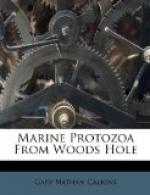[Illustration: Fig. 33.—Lionotus fasciola.]
KEY TO MARINE GENERA OF CHLAMYDODONTIDAE.
Diagnostic characters: Form usually ellipsoid, never very elongate. Transverse section of body circular or elliptical. The mouth is usually some distance from the anterior end and may be in the posterior part. Sometimes it is in the center of the ventral surface, again on the right side. The oesophagus invariably has a well-developed buccal armature, or a smooth peculiarly built oesophageal tube. Food particles of large size.
1. Body cylindrical. Cilia about
Genus *_Nassula_
entire body
Body flat 2
2. a. Without a caudal process 3
b. With a caudal process 5
3. a. Anterior end angular 4
on left side
b. Anterior end rounded Genus Chlamydodon
4. a. Dorsal striae and cilia present, Genus
Orthodon
ventral cilia
longer
b. Dorsal striae and cilia
absent; Genus *_Chilodon_
posterior end
not pointed
c. Dorsal striae and cilia
absent; Genus Scaphidiodon
posterior end
pointed
5. a. Caudal spine with posterior 6
bristle-like cilia
b. Caudal spine without posterior
Genus Trochilia
bristle-like cilia;
ventral cilia
reduced
6. a. With pigment spot on anterior Genus
AEgyria
angle
b. Without such pigment spot Genus Onychodactylus
c. Cilia on right edge only
of Genus *_Dysteria_
greatly reduced
ventral surface
* Presence at Woods Hole indicated by asterisk.
Genus NASSULA Ehr. ’33
(Dujardin ’41; Stein ’67; Cienkowsky ’55; Cohn ’66; Clap. et Lach. ’58; Kent ’81; Maupas ’83; Entz ’84; Fabre-Domergue ’88; Buetschli ’88; Shevyakov ’96.)




